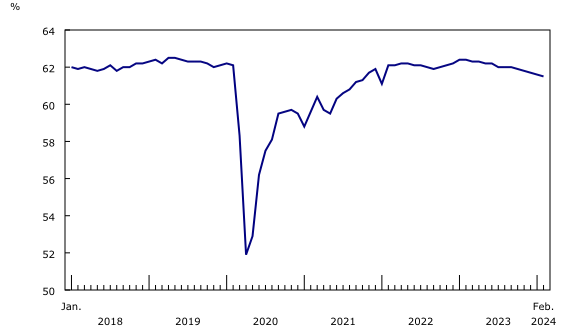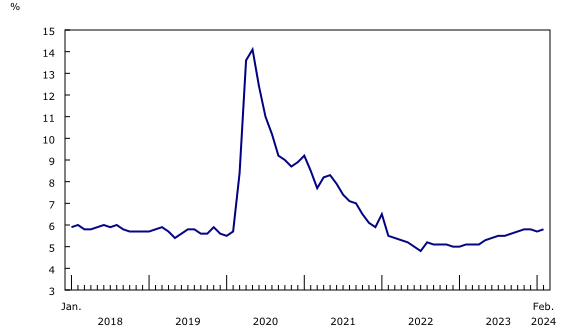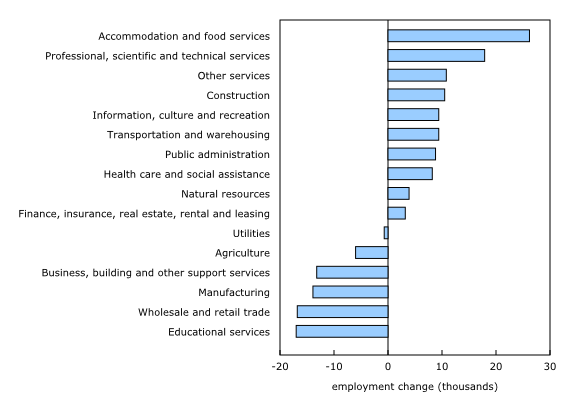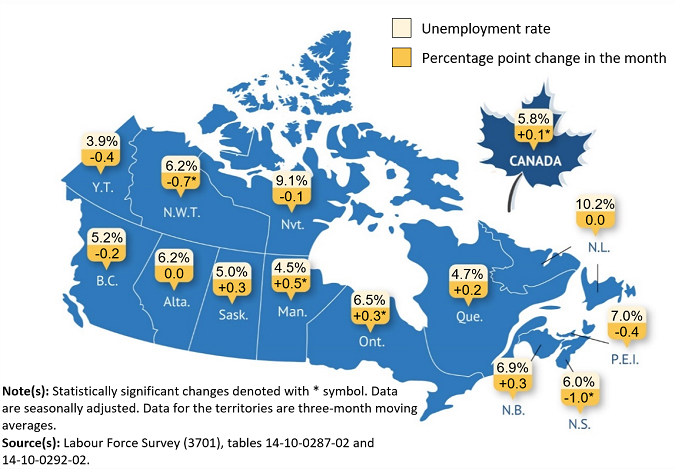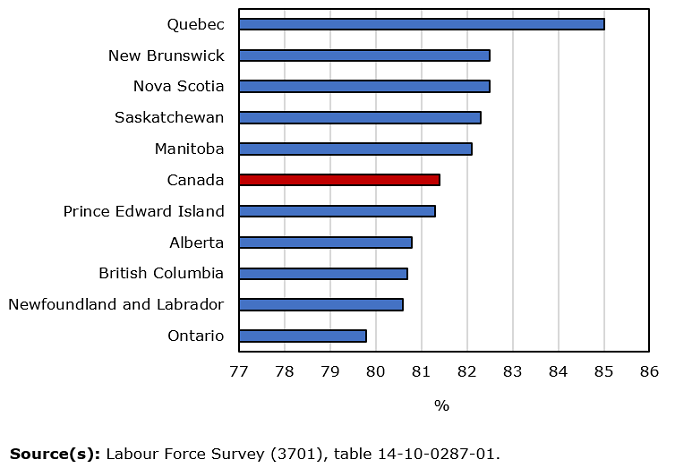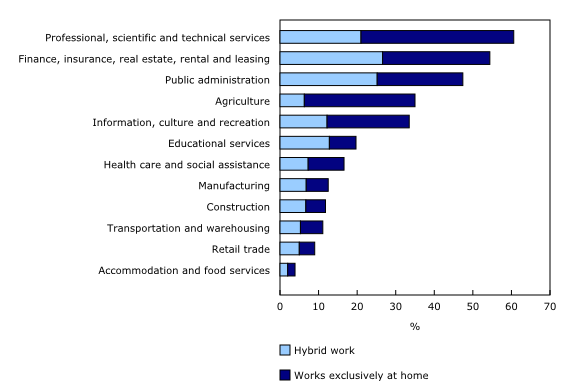Labour Force Survey, February 2024
Released: 2024-03-08
Highlights
Employment rose by 41,000 in February. The employment rate fell by 0.1 percentage points to 61.5%, as population growth (+0.3%) continued to outpace employment growth (+0.2%).
The unemployment rate increased 0.1 percentage points to 5.8%, offsetting a decline in January.
Employment increased among core-aged (25 to 54 years old) women (+45,000; +0.7%) and men (+23,000; +0.3%). At the same time, there were fewer women aged 55 and older employed (-29,000; -1.4%).
Employment increased in Alberta (+17,000; +0.7%) and Nova Scotia (+6,300; +1.2%), while it declined in Manitoba (-5,300; -0.7%). There was little change in the other provinces.
Employment gains were spread across several industries in the services-producing sector, led by accommodation and food services (+26,000; +2.4%) and professional, scientific, and technical services (+18,000; +0.9%). There were declines in other industries, led by educational services (-17,000; -1.1%) and manufacturing (-14,000; -0.8%).
Total hours worked in February were little changed in the month (+0.3%) but were up 1.3% compared with 12 months earlier.
Average hourly wages among employees rose 5.0% on a year-over-year basis in February (+$1.66 to $34.82), following an increase of 5.3% in January (not seasonally adjusted).
Employment gains continue to be outpaced by population growth
Employment rose by 41,000 (+0.2%) in February, following a similar-sized increase in January (+37,000). In February, employment growth was driven by an increase in full-time work (+71,000; +0.4%). On a year-over-year basis, full-time work was up by 260,000 (+1.6%) in February, while part-time work was up by 108,000 (+3.0%).
The employment rate—the proportion of the population aged 15 and older who are employed—fell by 0.1 percentage points to 61.5% in February. This was the fifth consecutive monthly decline, the longest period of consecutive decreases since the six-month period ending in April 2009. The employment rate in February 2024 was down 0.9 percentage points from the recent peak of 62.4% observed in February 2023. This downward trend is associated with rapid population growth, which has outpaced employment growth in the past year.
Employment increased by 38,000 (+1.5%) among self-employed workers in February 2024, the first monthly increase since August 2023. There was little change in the number of public and private sector employees in the month. From February 2023 to February 2024, employment grew at a faster pace for public sector employees (+197,000; +4.7%) than for private sector employees (+160,000; +1.2%), while self-employment was little changed over the period (+11,000; +0.4%).
Employment rate increases for core-aged women, holds steady for core-aged men
In February, employment rose among core-aged (25 to 54 years old) women (+45,000; +0.7%) and men (+23,000; +0.3%), following little change for both groups the previous month. For core-aged women, this was the first increase in employment since September 2023. The employment rate among core-aged women increased by 0.3 percentage points to 81.4% in February 2024, as employment growth outpaced population growth. The employment rate for core-aged men held steady at 87.2%.
From February 2023 to February 2024, employment rates for core-aged men and women have generally trended down, falling by 0.9 percentage points for core-aged men and by 0.5 percentage points for core-aged women. However, they remain above their respective 2017-to-2019 averages (86.5% for men and 79.3% for women), prior to the COVID-19 pandemic.
Employment and employment rates were little changed for young (aged 15 to 24) women and men in February 2024. On a year-over-year basis, the employment rate was down by 4.6 percentage points among young women and by 2.3 percentage points among young men.
Among women aged 55 and older, employment declined in February (-29,000; -1.4%) and the employment rate fell 0.4 percentage points to 30.1%. Employment was little changed among older men, and their employment rate fell 0.2 percentage points to 40.2% in February, following an increase of 0.3 percentage points in January.
Unemployment rate increases in February
The unemployment rate increased 0.1 percentage points to 5.8% in February, offsetting the decline recorded in January. The unemployment rate has held relatively steady in recent months, sitting at 5.8% for three of the past four months. This follows an upward trend from April 2023 to November 2023, when the rate increased from 5.1% to 5.8%. The labour force participation rate—the proportion of the population aged 15 and older who were employed or looking for work—held steady at 65.3% in February.
Unemployment rate up among core-aged and young men
Among core-aged men, the unemployment rate increased 0.2 percentage points to 5.3% in February, as more men of this age group looked for work. For core-aged women, the unemployment rate declined 0.4 percentage points to 4.6%, offsetting an increase observed in January.
The unemployment rate among young men aged 15 to 24 rose 1.0 percentage points to 12.0% in February, while for young women it was little changed at 11.1%. On a year-over-year basis, the unemployment rate was up for both young women (+1.8 percentage points) and young men (+1.2 percentage points). Among male and female youth, the unemployment rate was up for students (+2.1 percentage points to 11.5%) and non-students (+1.3 percentage points to 12.0%) over the period (not seasonally adjusted).
The youth labour force participation rate—the proportion of the population aged 15 to 24 who were either employed or unemployed—rose 0.6 percentage points in February to 63.3%. The increase was the first since December 2022, and followed a decline of 0.8 percentage points in January 2024. On a year-over-year basis, the participation rate was down for young women (-3.8 percentage points to 62.9%) and young men (-1.8 percentage points to 63.6%) in February. Most youth who were not in the labour force were attending school—this proportion was 89.1% in February, compared with 87.5% one year earlier (not seasonally adjusted).
In February, the unemployment rate for women aged 55 and older rose by 0.5 percentage points to 4.5%, while for men of the same age group, it was little changed at 4.6%.
Employment gains spread across services-producing industries
In February, employment in accommodation and food services grew by 26,000 (+2.4%), following a decline of 30,000 (-2.7%) in January. On a year-over-year basis, employment in this industry was little changed in February, and remained below its pre-pandemic level. In February 2024, employment in accommodation and food services was down 7.9% (-96,000) compared with the 2017-to-2019 average.
Employment in professional, scientific, and technical services rose by 18,000 (+0.9%) in February, offsetting a decline of 17,000 (-0.9%) in January. On a year-over-year basis, employment in this industry was up 85,000 (+4.6%), the second-largest year-over-year increase among industries, after transportation and warehousing (+104,000; +10.6%).
In February, employment also increased in "other services" (which includes personal and repair services) (+11,000; +1.4%) and public administration (+9,000; +0.7%).
The number of people working in education services fell by 17,000 (-1.1%), partially offsetting an increase of 28,000 (+1.8%) in January. Employment also declined in manufacturing (-14,000; -0.8%), business, building, and other support services (-13,000; -1.9%) and agriculture (-6,000; -2.6%) in February.
Employment up in Alberta and Nova Scotia in February
Following little change in the previous two months, employment in Alberta rose by 17,000 (+0.7%) in February, bringing overall gains since September 2023 to 73,000 (+3.0%). The unemployment rate held steady at 6.2% in February 2024.
In Nova Scotia, employment increased by 6,300 (+1.2%) in February, bringing cumulative gains since August 2023 to 25,000 (+5.1%). The employment rate in Nova Scotia rose 0.5 percentage points to 58.8% in February 2024, the highest rate for the province since June 2013. On a year-over-year basis, Nova Scotia and Prince Edward Island were the only two provinces to record increases in their employment rates in February. The unemployment rate in Nova Scotia decreased by 1.0 percentage points to 6.0% in the month, and was little changed from February 2023.
In Manitoba, employment declined by 5,300 (-0.7%) in February 2024, following an increase in January. The unemployment rate increased 0.5 percentage points to 4.5% in February. Despite the increase in the month, Manitoba has posted the lowest unemployment rate among the provinces since November 2023.
Employment in Ontario held steady in February 2024, and has shown little overall change since June 2023. The employment rate fell from a recent peak of 62.2% reached in June 2023 to 60.6% in February 2024, as the population aged 15 and older in the province grew by 316,000 (+2.5%). With more people in the labour force looking for work, the unemployment rate increased 0.3 percentage points to 6.5% from January to February 2024.
Quebec showed little employment change for the fifth consecutive month, and the unemployment rate held steady at 4.7% in February. In the 12 months to February 2024, employment in Quebec increased by 40,000 (+0.9%), while the employment rate fell from 62.3% to 61.6% over the period.
For further information on key province and industry level labour market indicators, see "Labour Force Survey in brief: Interactive app."
In the spotlight: Women in the Canadian labour market
March 8 is International Women's Day, a global day to recognize the achievements of women and girls and reflect on the progress made towards gender equality, while acknowledging the challenges and barriers that still exist.
In February, women accounted for 47.3% of the Canadian labour force, with 9.7 million women employed. The employment rate of women aged 25 to 54 was 81.4% in February, below the record high of 82.0% reached in January 2023 and March 2023, but above the pre-pandemic average of 79.3% recorded from 2017 to 2019.
In February 2024, the employment rate for core-aged women was highest in Quebec (85.0%), 2.5 percentage points above New Brunswick (82.5%) and Nova Scotia (82.5%), and 3.6 percentage points above the national average of 81.4%. The employment rate of core-aged women was lowest in Ontario at 79.8%.
The experiences of women in the labour market can vary based on demographic characteristics. For instance, among core-aged women in 2023, the employment rate of Filipino women (87.1%) was notably higher than the national average (81.6%). Meanwhile, employment rates were lower for Arab women (60.8%) and West Asian women (66.3%).
The gender wage gap in Canada has declined over time but remains persistent. In February 2024, women aged 25 to 54 earned $0.87 for every dollar earned by men of the same age group, little changed from 12 months earlier ($0.86), and on par with the pre-pandemic average from 2017 to 2019 ($0.87) (not seasonally adjusted).
The size of the gender wage gap varies by occupational group. While women earn less than men across all broad occupational groups, the gap is more pronounced in male-dominated occupations. In manufacturing and utilities, core-aged women earned 22.4% less on average than their male counterparts in February, while in natural resources, agriculture and related production occupations, core-aged women earned 17.2% less. In contrast, in health occupations—where women comprised 82.3% of the workforce—core-aged women earned 1.6% less on average than men (not seasonally adjusted).
Women accounted for 35.3% of all those employed in management occupations in 2023, the same share as in 2022, and little changed from the average from 2017 to 2019 (34.9%). Under one in three (30.1%) of those employed in legislative and senior management occupations were women in 2023.
In the Spotlight: Working from home continues to be an important feature of the work week for many Canadians
Nearly four years ago, the pandemic brought on an unprecedented increase in the number of Canadians who work from home. While the proportion of Canadians working from home has decreased considerably from the peak of 41.1% reached in April 2020, working remotely continues to be an important part of the weekly work routine for many Canadians.
In February 2024, 13.5% of workers usually worked exclusively from home and a further 11.4% had a hybrid arrangement—that is, they usually worked some hours at home, and some hours at locations other than home (population aged 15 to 69, not seasonally adjusted). Compared with November 2023—the last time information on work location was collected in the Labour Force Survey—the share of workers who usually work exclusively from home was up slightly (+0.9 percentage points), and the proportion of hybrid workers was little changed.
The proportion working at least some of the time from home in February 2024 was higher among women (27.8%) than among men (22.4%).
Working from home—either exclusively or as part of a hybrid arrangement—is notably higher among self-employed workers. In February 2024 more than 4 in 10 self-employed workers (42.6%) indicated that they usually worked at least some of the time from home. Public sector employees (25.9%) were also more likely to work from home than private sector employees (21.3%).
Consistent with patterns observed since the start of the pandemic, the share of workers who either worked exclusively from home or had a hybrid arrangement was highest in professional, scientific, and technical services (60.6%), finance, insurance, real estate, rental and leasing (54.4%) and public administration (47.4%) in February 2024.
Did you know we have a mobile app?
Get timely access to data right at your fingertips by downloading the StatsCAN app, available for free on the App Store and on Google Play.
Sustainable Development Goals
On January 1, 2016, the world officially began implementation of the 2030 Agenda for Sustainable Development—the United Nations' transformative plan of action that addresses urgent global challenges over the next 15 years. The plan is based on 17 specific sustainable development goals.
The Labour Force Survey is an example of how Statistics Canada supports the reporting on the Global Goals for Sustainable Development. This release will be used in helping to measure the following goals:


Note to readers
The Labour Force Survey (LFS) estimates for February are for the week of February 11 to 17, 2024.
The LFS estimates are based on a sample and are therefore subject to sampling variability. As a result, monthly estimates will show more variability than trends observed over longer time periods. For more information, see "Interpreting Monthly Changes in Employment from the Labour Force Survey."
This analysis focuses on differences between estimates that are statistically significant at the 68% confidence level.
LFS estimates at the Canada level do not include the territories.
The LFS estimates are the first in a series of labour market indicators released by Statistics Canada, which includes indicators from programs such as the Survey of Employment, Payrolls and Hours (SEPH); Employment Insurance Statistics; and the Job Vacancy and Wage Survey. For more information on the conceptual differences between employment measures from the LFS and those from the SEPH, refer to section 8 of the Guide to the Labour Force Survey (71-543-G).
Face-to-face personal interviewing resumed in November 2022. Telephone interviews continued to be conducted by interviewers working from their homes rather than Statistics Canada's call centres, as they have since March 2020. About 49,400 interviews were completed in February and in-depth data quality evaluations conducted each month confirm that the LFS continues to produce an accurate portrait of Canada's labour market.
An article presenting two collection initiatives that are underway to restore LFS response rates to the greatest extent possible was published February 16 in the Labour Statistics: Technical Papers series: Ensuring that the Labour Force Survey Remains the Cornerstone of Canada's Labour Market Information Ecosystem.
The employment rate is the number of employed people as a percentage of the population aged 15 and older. The rate for a particular group (for example, youths aged 15 to 24) is the number employed in that group as a percentage of the population for that group.
The unemployment rate is the number of unemployed people as a percentage of the labour force (employed and unemployed).
The participation rate is the number of employed and unemployed people as a percentage of the population aged 15 and older.
Full-time employment consists of persons who usually work 30 hours or more per week at their main or only job.
Part-time employment consists of persons who usually work less than 30 hours per week at their main or only job.
Total hours worked refers to the number of hours actually worked at the main job by the respondent during the reference week, including paid and unpaid hours. These hours reflect temporary decreases or increases in work hours (for example, hours lost due to illness, vacation, holidays or weather; or more hours worked due to overtime).
In general, month-to-month or year-to-year changes in the number of people employed in an age group reflect the net effect of two factors: (1) the number of people who changed employment status between reference periods, and (2) the number of employed people who entered or left the age group (including through aging, death or migration) between reference periods.
Information on racialized groups
Data on "racialized groups" are derived from the "visible minority" variable. "Visible minority" refers to whether or not a person belongs to one of the visible minority groups defined by the Employment Equity Act. The Employment Equity Act defines visible minorities as "persons, other than Aboriginal peoples, who are non-Caucasian in race or non-white in colour." The visible minority population consists mainly of the following groups: South Asian, Chinese, Black, Filipino, Latin American, Arab, Southeast Asian, West Asian, Korean and Japanese.
Seasonal adjustment
Unless otherwise stated, this release presents seasonally adjusted estimates, which facilitate comparisons by removing the effects of seasonal variations. For more information on seasonal adjustment, see Seasonally adjusted data – Frequently asked questions.
Population growth in the Labour Force Survey
The LFS target population includes all persons aged 15 years and older whose usual place of residence is in Canada, with the exception of those living on reserves, full-time members of the regular Armed Forces and persons living in institutions (including inmates of penal institutions and patients in hospitals and nursing homes).
The LFS target population includes temporary residents—that is, those with a valid work or study permit, their families, and refugee claimants—as well as permanent residents (landed immigrants) and the Canadian-born.
Information gathered from LFS respondents is weighted to represent the survey target population using population calibration totals. These totals are updated each month, using the most recently available information on population changes, including changes in the number of non-permanent residents. LFS population calibration totals are derived from Canada's official population estimates using similar sources and methods, with minor adjustments being made to reflect exclusions from the LFS target population.
Revisions to seasonally-adjusted Labour Force Survey tables
On January 29, 2024, revised LFS data were released, as is done every year, resulting in minor changes to recent estimates. Estimates from January 2021 to December 2023 were republished incorporating a fine-tuning of the parameters used in the seasonal adjustment process. Estimates from January 2024 onward also use the updated seasonal adjustment factors. For more information on the changes, see Labour Force Survey: Revisions, 2021 to 2023.
Next release
The next release of the LFS will be on April 5. March data will reflect labour market conditions during the week of March 10 to 16.
Products
More information about the concepts and use of the Labour Force Survey is available online in the Guide to the Labour Force Survey (71-543-G).
The product "Labour Force Survey in brief: Interactive app" (14200001) is also available. This interactive visualization application provides seasonally adjusted estimates by province, sex, age group and industry.
The product "Labour Market Indicators, by province and census metropolitan area, seasonally adjusted" (71-607-X) is also available. This interactive dashboard provides customizable access to key labour market indicators.
The product "Labour Market Indicators, by province, territory and economic region, unadjusted for seasonality" (71-607-X) is also available. This dynamic web application provides access to labour market indicators for Canada, provinces, territories and economic regions.
The product Labour Force Survey: Public Use Microdata File (71M0001X) is also available. This public use microdata file contains non-aggregated data for a wide variety of variables collected from the Labour Force Survey. The data have been modified to ensure that no individual or business is directly or indirectly identified. This product is for users who prefer to do their own analysis by focusing on specific subgroups in the population or by cross-classifying variables that are not in our catalogued products.
Contact information
For more information, or to enquire about the concepts, methods or data quality of this release, contact us (toll-free 1-800-263-1136; 514-283-8300; infostats@statcan.gc.ca) or Media Relations (statcan.mediahotline-ligneinfomedias.statcan@statcan.gc.ca).
- Date modified:



